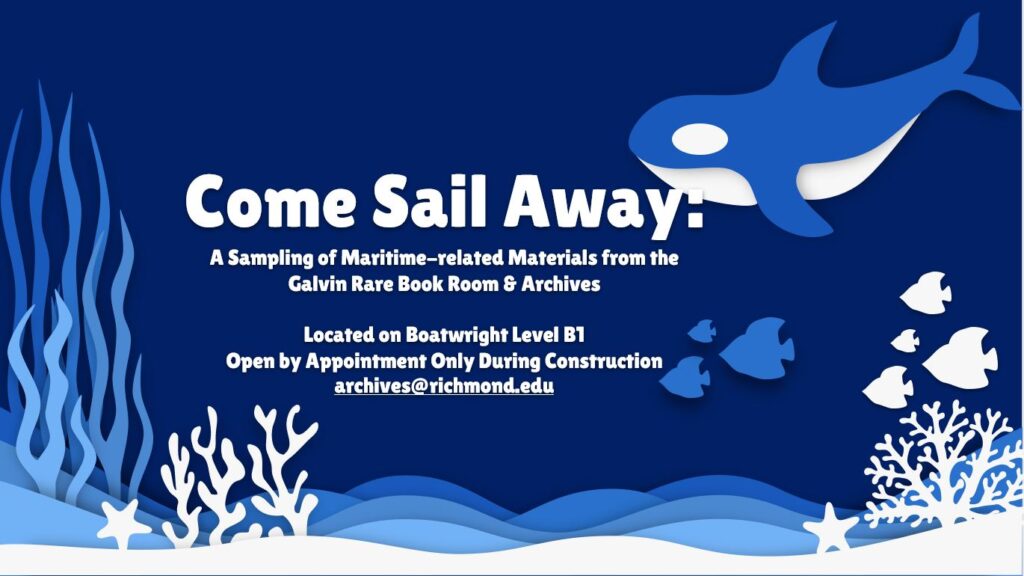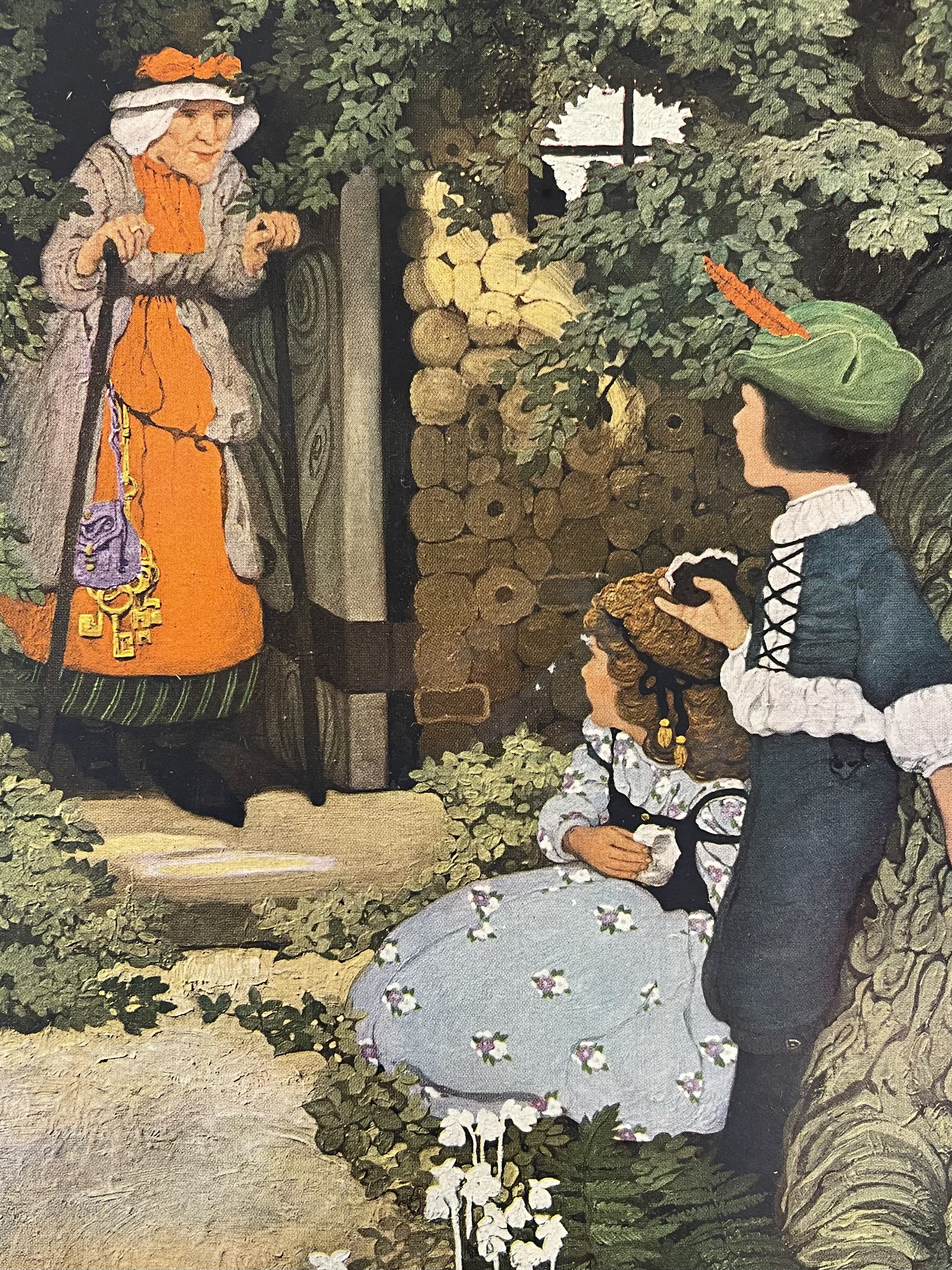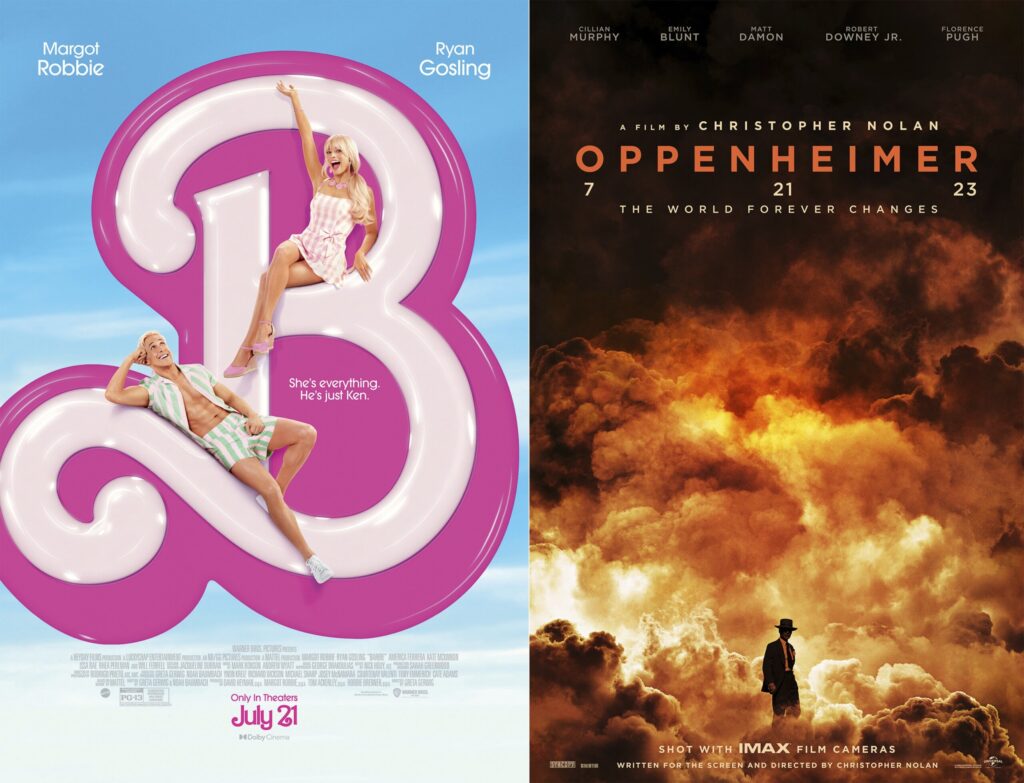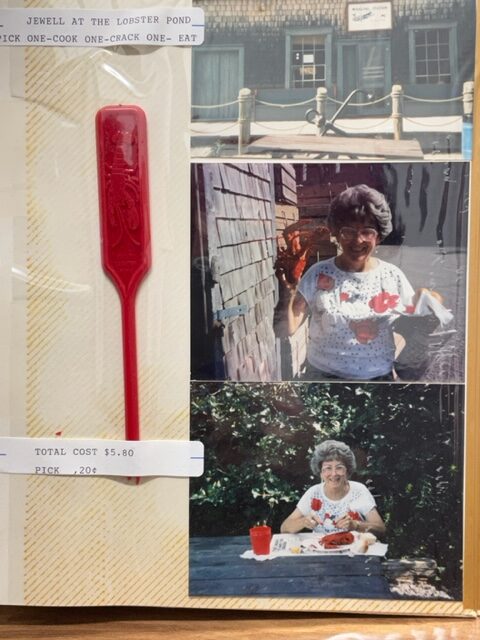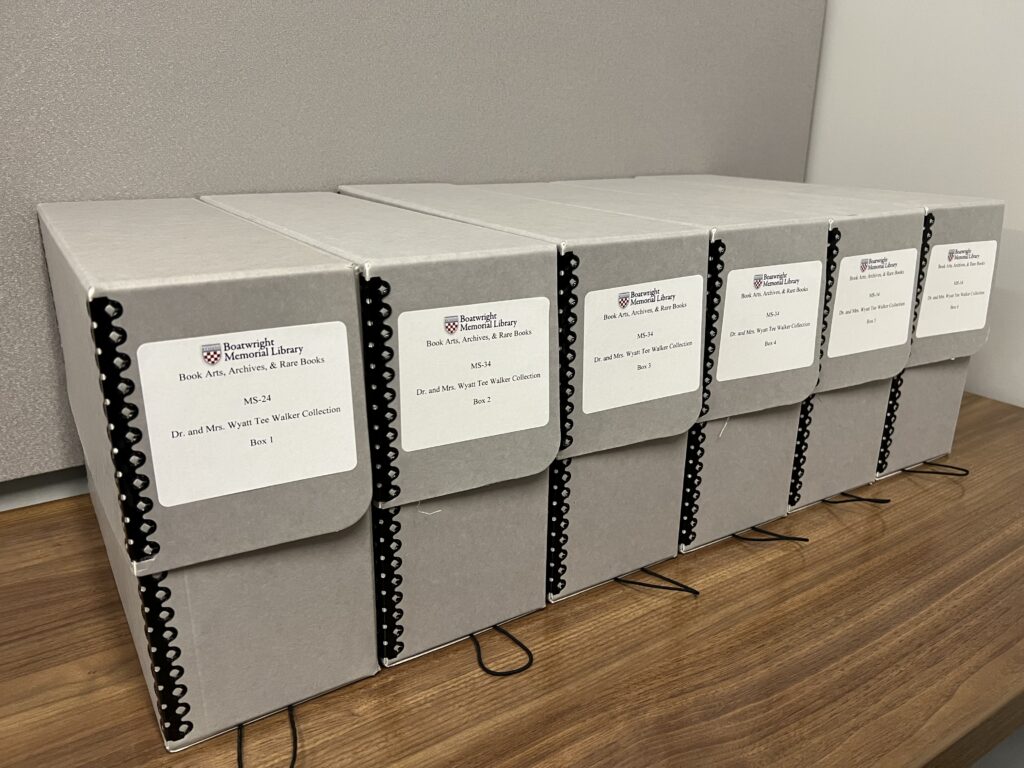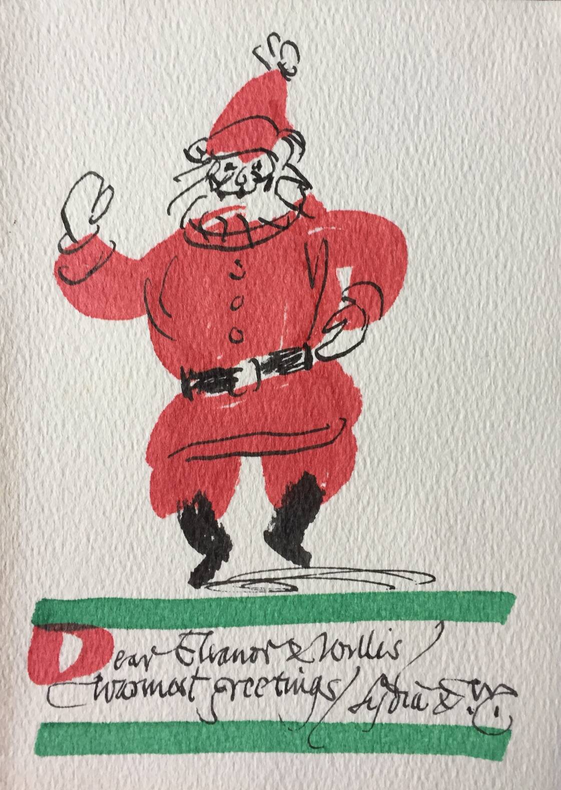As the new semester begins, the Book Arts, Archives, & Rare Books division at Boatwright Memorial Library is pleased to announce a specialized exhibit that highlights a distinctive component of its rare book and archival collections: maritime-related materials. Many of these items, which reside in the Galvin Rare Book Room & Archives, have been acquired largely through the generous endowment of the Beverly Lyle Britton Fund. Beverly Lyle Britton, an esteemed alumnus of Richmond College (Class of 1935), devoted much of his professional life to service in the United States Navy, where he held notable positions including Special Assistant to the Secretary of the Navy and Press Liaison. Established following Britton’s passing in 1995, the fund is dedicated to procuring materials that pertain specifically to the United States Navy, maritime history, and the sea. This ongoing financial support has enabled the library to continuously enhance its collection with annual acquisitions.
The current exhibit, titled Come Sail Away, offers a curated selection of the library’s maritime-themed holdings, providing a window into the breadth and depth of the collection. This exhibit serves not only as a sampling of the diversity of the library’s resources but also as an invitation to students, faculty, staff, and the broader academic community to engage with and explore these valuable materials for research and scholarship. The exhibit is located on level 2 of Boatwright Library, just outside the administrative offices.
Below is a list of the exhibit’s categories and some of the corresponding materials on display that are available for use through the Galvin Rare Book Room & Archives. For a more comprehensive exploration of the library’s rare book holdings, we encourage the use of the online catalog—pro tip: select the “Rare Books” tab to focus your search on materials housed in the Galvin Rare Book Room. Additionally, searching for “Britton” will yield results for items procured through the Britton Fund. Archival materials are accessible through the ArchivesSpace database, where new and updated content is continually integrated as it becomes available.
Ships & Ship Life
- David M. Clinger, Romantick & Whimsical Words of the Sea and of Sailing-ships Stingray Point, VA: 2004. MS-35 David M. Clinger Collection, Box 26 This miniature book was hand-set in well-work Garamond foundry type and printed on the antique press of Chesapeake Bay Retriever and Sandy Bottom News at Stingray Point Farm, Stingray Point, Virginia. This first edition was limited to 20 copies.
- Herman Melville, Moby Dick: or, The Whale New York: Norton, 1976 Illustrated by Warren Chappell, Richmond College Class of 1926 — 50th Anniversary Class Gift from the Class of 1926
- Frank Shay, ed. Iron Men & Wooden Ships: Deep Sea Chanties Garden City, NY: Doubleday, Page, & Co., 1924 In 1920, Shay opened a tiny bookshop where he both sold and published books. The initial volume of this work was published by Shay in 1921, then this expanded edition was picked up and published by Doubleday in 1924. (Note: This book is a newly acquired work that is in the process of being cataloged into the collection.)
Latitude & Longitude
- Matthew Fontaine Maury, A New Theoretical and Practical Treatise on Navigation: in which the auxiliary branches of mathematics and astronomy, comprised of algebra, geometry,…. variation of the compass, etc., are treated of. Also the theory and most simple methods of finding time, latitude, and longitude….. Philadelphia: Key & Biddle, 1836 Inscribed by the author. Maury was a naval officer and oceanographer and considered one of the founding pioneers of modern oceanography. This work was his first published book, completed at the age of 30 after participating in three extended voyages, including the first circumnavigation of the globe by a U.S. Navy vessel. Maury served as the head of the United States Naval Observatory from 1844-1861.
- William Whiston, The Longitude discovered by the eclipses, occultations, and conjunctions of Jupiter’s planets: with descriptions of those refracting and reflecting telescopes… that are useful for the discovery of longitude both at land and sea… London: Printed for John Whiston at Boyle’s Head, Fleet Street, 1738 Instrumental in helping pass the British Longitude Act of 1714, Whiston spent a considerable amount of time working on the problem of longitude. This first-edition work explains the various instruments and experiments Whiston explored in his attempts.
Sea-faring Adventures
- Hamilton M. Baskerville, My Cruise Diary: North Cape & Russia Cruise, 1931 Richmond: Whittet & Shepperson, 1932. Privately printed for the author for distribution among his friends, #62/200. This work is inscribed by the author: “For the library of the University of Richmond, presented by the author, alumnus, 1899-1900.”
- Frank I. Wilson, Sketches of Nassau… Raleigh, NC, 1864 Teacher, reporter, and writer, Frank Wilson of North Carolina published this work documenting his travels to Nassau in 1864 aboard a blockade-runner.
Exploring the South Pacific
- Alexander Dalrymple, An Historical Collection of Several Voyages & Discoveries in the South Pacific Ocean London: Printed for the author and sold by J. Nourse, bookseller in ordinary to his majesty, 1770-1771 This important collection, published in two volumes in 1770-1771, contains accounts of notable Iberian and Dutch voyages in the southern hemisphere, translated and edited by Alexander Dalrymple (1737-1808). Hydrographer to the Admiralty from 1795, Dalrymple produced this work as part of his research into the belief at the time that there existed an undiscovered continent in the South Pacific. These volumes were intended to demonstrate the knowledge of the region to date. The first volume covers sixteenth-century Spanish and Portuguese voyages, beginning with Ferdinand Magellan and including those of Juan Fernández, Álvaro de Mendaña y Neira, and Pedro Fernandes de Queirós. The second volume contains the seventeenth- and eighteenth- century Dutch voyages of Jacob le Maire and William Schouten, and Abel Tasman.
- Rockwell Kent, Voyaging Southward from the Strait of Magellan New York: G.P. Putnam’s Sons, 1924 Graphic artist and avid traveler Rockwell Kent takes readers on an illustrated adventure of his sailing the southern tip of South America, dramatically illustrated with the author’s woodcuts.
Artist Book
- Jessica Spring, Fathoming Tacoma, WA: Springtide Press, 2015 Book Arts Collection #37 From the colophon: “”[L]etterpress printed with handset Latin Condensed and Bernhar Gothic with vintage maritime cuts. The edition includes a varied copy for each of the seven seas, featuring collectible tobacco cards sold with packages of cigarettes from 1924-37. Printed by Jessica Spring and bound in an adaptation of Hedi Kyle’s flag book structure with Japanese maritime maps from 1945 [on exterior of concertina spine]. [Drop-spine] boxes bound and portholes scuttled by Gabby Cooksey. Removable flags are held in place with sewing rather than attached to concertina spine (as in the traditional flag book binding by Hedi Kyle). Concertina attached at either end to blue cloth over boards with three circular cut-outs in each, displaying illustrations and the title. Spine is letterpress printed with various nautical terms and their definitions on recto, with historic maritime maps on verso.”
Manuscript Material
- SC-1: Ship’s Log of Whaling Journeys (1850s) This manuscript documents at least four different voyages during the 1850s, although the entries record varying levels of detail. Many are dated and often include the longitude and latitude of the vessel as well as information about the weather. The intent of the various sailings was clear, no matter the ship: they were hunting whales. On September 4, 1858, for example, the author documented that the crew “saw a very large school of sperm whale which is something uncommon in this latitude and longitude. Sketches and drawings of whales highlight some pages, especially when their hunt was successful. In fact, the main image on our blog is from this manuscript!

